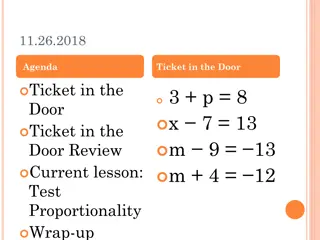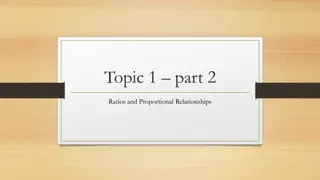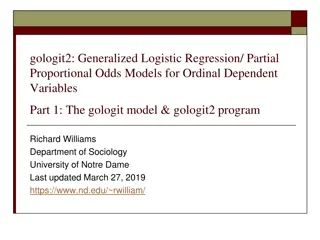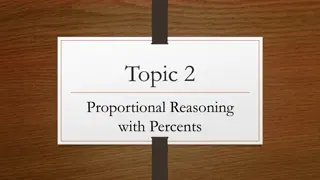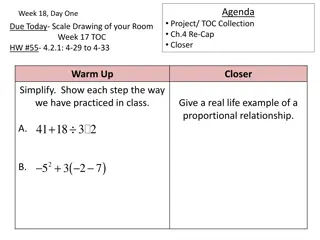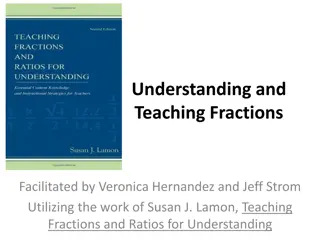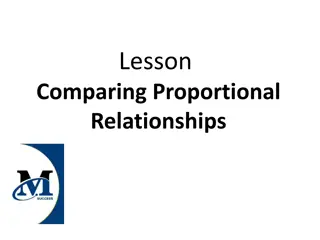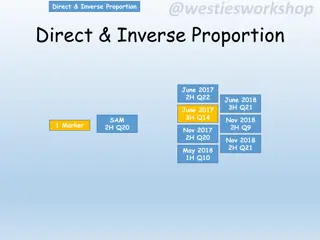Understanding Proportional and Nonproportional Relationships in Mathematics
Proportional relationships involve quantities having a constant ratio or unit rate, while nonproportional relationships lack this constant ratio. By examining examples such as earnings from babysitting and costs of movie rentals, we can grasp the differences between these two types of relationships. Proportional relationships display as straight lines passing through the origin on graphs, while nonproportional relationships deviate from this pattern. Equations and graphical representations help visualize and comprehend these concepts in a mathematical context.
- Proportional relationships
- Nonproportional relationships
- Mathematics
- Graphical representations
- Equations
Download Presentation

Please find below an Image/Link to download the presentation.
The content on the website is provided AS IS for your information and personal use only. It may not be sold, licensed, or shared on other websites without obtaining consent from the author. Download presentation by click this link. If you encounter any issues during the download, it is possible that the publisher has removed the file from their server.
E N D
Presentation Transcript
Proportional relationships: Quantities have a constant ratio, or unit rate Nonproportional relationships: Quantities do not have a constant ratio, or unit rate
Example 1: The following chart shows how much money Layla earns babysitting. Is the amount of money she earns proportional to the number of hours that she spends babysitting? money Hours (h) Money earned ($) hours $16.50= $5.50 $5.50 1 5.50 3 1 1 2 11.00 $11= $5.50 $22= $5.50 3 16.50 2 1 4 1 4 22.00 Find the unit rate of money earned to hours worked for each pair of values. There is a proportional relationship between money earned and hours since $5.50 all of the ratios have a unit rate of . 1 hr
Lets graph this proportional relationship from Ex. 1 on an xy-plane. We typically put time (hours) on the x-axis, and the money earned ($) on the y-axis. Layla s Babysitting Money y Plot points (x, y) from the table. 22.00 Hours (h) Money Earned ($) Point (x, y) Money Earned ($) 16.50 1 5.50 (1, 5.50) 2 11.00 (2, 11) 11.00 3 16.50 (3, 16.50) 5.50 4 22.00 (4, 22) x 1 2 3 4 5 Hours worked The graph of a proportional relationship: is a straight line, AND it passes through the origin, or point (0,0).
We can write an equation to represent the proportional relationship from Ex. 1. Layla s Babysitting Money y Hours (h) Money Earned ($) 22.00 Money Earned ($) 1 5.50 16.50 2 11.00 11.00 3 16.50 5.50 4 22.00 x 1 2 3 4 5 money earned . 5 $ 50 = Hours worked hours 1 hr In words, Money earned = (money per hour)(number of hours) y = $5.50 x As an equation,
Example 2: Movie World charges a $6 monthly membership fee plus $1 per movie rental. Is the monthly cost proportional to the number of movies rented? Explain . Find the unit rate of the monthly cost to the number of rentals for each pair of values. Movies rented 1 2 3 4 Monthly Cost ($) 7 8 9 10 monthly cost no. of rentals 8= $4 $9= $3 $10= $2.50 $7= $ 7 2 1 3 1 4 1 1 There is NOT a proportional relationship between monthly cost and number of movie rentals since all of the ratios between the two quantities are not equal.
Lets look at a graph this nonproportional relationship from Ex. 2. Movie rentals will be on the x-axis, and the monthly cost ($) will be on the y-axis. Monthly Cost of Movies from Movie World y 16 Monthly cost ($) Point (x, y) Rentals 14 1 7 (1, 7) 12 2 8 (2, 8) 10 Cost ($) 3 9 (3, 9) 8 6 4 10 (4, 10) 4 2 This graph shows a nonproportional relationship. Even though this graph is a straight line, it does not pass through the origin. x 1 2 3 4 Number of movie rentals









